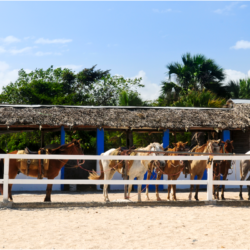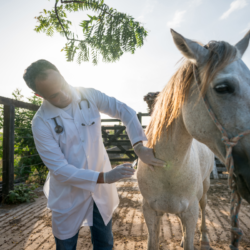Strangles is a highly contagious respiratory disease that mainly affects young horses. Caused by the bacterium Streptococcus equi subsp. equi, it leads to severe complications and can have significant economic consequences.
What causes this disease?
Strangles is an infection of the upper respiratory tract of horses, caused by the bacterium Streptococcus equi subspecies equi, a strict Gram-positive pathogen. Unlike S. equi subsp. zooepidemicus, which is part of the commensal flora, S. equi subsp. equi is exclusively pathogenic. Little is known about the survival of this bacterium in the outdoor environment, although studies suggest that it can survive for several months in favourable conditions of temperature and humidity.
The disease is highly contagious and is transmitted mainly through direct contact with infected horses or indirect contact with contaminated objects such as water troughs, feed troughs and even the clothing of care staff. Sick and convalescent horses, as well as healthy carriers, are the main sources of contamination. These healthy carriers harbour the bacteria in their guttural pouches and can spread it for several weeks after clinical recovery.
Strangles mainly affects young horses under five years of age, but can affect horses of any age. Morbidity in groups of naïve horses can reach 100%, although mortality remains low, in the region of 1 to 5%, generally due to complications in young foals.
What are the symptoms of strangles?
Strangles manifests itself through a variety of symptoms, depending on the severity of the infection. After a short incubation period of 3 to 7 days, infected horses show clinical signs suggestive of the classical or catarrhal form of the disease.
Initial symptoms include lethargy, fever of up to 40°C and anorexia. Serous rhinitis rapidly develops into mucopurulent and then purulent discharge. Pharyngitis accompanied by dysphagia develops, with hypertrophy of the mandibular and retropharyngeal lymph nodes, often causing stiffness of the neck. If left untreated, these lymph nodes abscess within 3 to 7 days, causing creamy, yellowish pus to drain either externally or into the guttural pouches.
In favourable cases, recovery takes 2 to 4 weeks, but more serious forms can occur. The erratic or mongrel form of strangles is characterised by multiple abscesses in various parts of the body, including the skin, nervous system, lungs and genital tract.
Immune-mediated disorders, although rare, include haemorrhagic purpura, vasculitis with subcutaneous oedema, petechiae and mucosal ecchymosis. Other complications may include glomerulonephritis, hair loss, stomatitis and various forms of myopathy.
How is the disease diagnosed?
Diagnosis of strangles is based primarily on observation of the characteristic clinical signs and analysis of various samples.
- Clinical signs: The symptoms of strangles are often sufficiently suggestive to guide the diagnosis, especially if the epidemiological context is highly contagious.
- Paraclinical examination: Blood count analysis and fibrinogen assay reveal constant neutrophilic leukocytosis and hyperfibrinogenemia, sometimes with anaemia and thrombocytopenia.
- Detection of abscesses: Endoscopy of the guttural pouches can be used to detect non-external abscesses. For erratic forms, thoracic and abdominal X-rays or ultrasound may be necessary.
- Identification of the pathogen: Bacteriology is used to culture and isolate the bacteria from various samples (nasopharyngeal swabs, nasal lavage). However, PCR (Polymerase Chain Reaction) is faster and more sensitive, enabling the presence of S. equi DNA to be detected. This method is particularly useful because of its accuracy and speed.
- Serology: This detects antibodies to S. equi. ELISA-type serological tests are used to assess past exposure to the bacterium and to aid herd management.
What treatments are available?
Treatment for strangles depends on the stage and severity of the infection. In the absence of complications, most horses recover without specific treatment. Here are some treatment options:
- Rest and supportive care: Place the horse in a calm environment with access to water and moist, easy-to-swallow feed.
- Local treatments: Warm poultices such as Animalintex can be applied to help the abscesses mature. If the abscesses do not rupture naturally, drainage by surgical incision and daily cleaning with an antiseptic solution may be necessary.
- Anti-inflammatories: Non-steroidal anti-inflammatory drugs can help reduce fever and pain, making eating and drinking easier.
- Antibiotics: The use of antibiotics is controversial. In fact, it may delay the maturation of abscesses and encourage their reappearance once treatment has been stopped. However, in severe cases or with metastatic abscesses, antibiotics may be essential. Their use must be rational and under veterinary supervision.
- Treatment of complications: Metastatic abscesses require long-term antibiotic treatment. Haemorrhagic purpura is treated with corticosteroids such as dexamethasone, sometimes accompanied by antibiotics or anti-inflammatories.
What are the natural alternatives?
In addition to conventional treatments, certain medicinal plants can help relieve the symptoms of strangles:
- Eucalyptus: Antiseptic, expectorant and decongestant, it helps to thin and eliminate bronchial secretions.
- Thyme: Antibacterial and antitussive, it soothes bronchial spasms and tones the respiratory system.
- Pine bud: Expectorant and decongestant, it increases respiratory capacity.
- Marshmallow: Soothes irritation of bronchial mucous membranes, reducing hypersecretion.
- Hyssop: Fluidifying and expectorant, it helps to eliminate bronchial secretions.
- Rosehip: Rich in vitamin C, it reinforces the protective mucus of the lung membranes.
- Burdock: Helps to eliminate toxins and metabolic residues from the body.
- Echinacea: Stimulates the immune system by increasing the production of white blood cells and interferon.
What are the means of prevention?
Strangles is prevented by strict sanitary measures and the use of vaccines where possible.
- Vaccination: In Europe, a live attenuated vaccine is available, offering protection for 3 months. However, it does not suppress bacterial excretion and cannot distinguish between vaccinated and infected horses.
- Health prophylaxis: Screening for healthy carriers and shedding horses is essential. New arrivals should be quarantined and screened.
- Pasture management and equipment: Paddocks where sick horses have been kept should remain unoccupied for at least four weeks. Single-use equipment must be used and a foot bath placed in front of each contaminated stall.
In the event of an epizootic, :
- Stop all horse movements.
- Take daily temperature readings.
- Isolate sick and feverish horses.
- Clean and disinfect all equipment and stalls in contact with a sick horse.
- Use single-use equipment in infected areas.
By adopting these preventive measures and remaining vigilant, you can limit the spread of this highly contagious disease.





